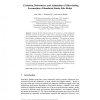Free Online Productivity Tools
i2Speak
i2Symbol
i2OCR
iTex2Img
iWeb2Print
iWeb2Shot
i2Type
iPdf2Split
iPdf2Merge
i2Bopomofo
i2Arabic
i2Style
i2Image
i2PDF
iLatex2Rtf
Sci2ools
GECCO
2004
Springer
2004
Springer
Evolution, Robustness, and Adaptation of Sidewinding Locomotion of Simulated Snake-Like Robot
Inspired by the efficient method of locomotion of the rattlesnake Crotalus cerastes, the objective of this work is automatic design through genetic programming, of the fastest possible (sidewinding) locomotion of simulated limbless, wheelless snake-like robot (Snakebot). The realism of simulation is ensured by employing the Open Dynamics Engine (ODE), which facilitates implementation of all physical forces, resulting from the actuators, joints constrains, frictions, gravity, and collisions. Empirically obtained results demonstrate the emergence of sidewinding locomotion from relatively simple motion patterns of morphological segments. Robustness of the sidewinding Snakebot, considered as ability to retain its velocity when situated in unanticipated environment, is illustrated by the ease with which Snakebot overcomes various types of obstacles such as a pile of or burial under boxes, rugged terrain and small walls. The ability of Snakebot to adapt to partial damage by gradually improvi...
| Added | 01 Jul 2010 |
| Updated | 01 Jul 2010 |
| Type | Conference |
| Year | 2004 |
| Where | GECCO |
| Authors | Ivan Tanev, Thomas S. Ray, Andrzej Buller |
Comments (0)

